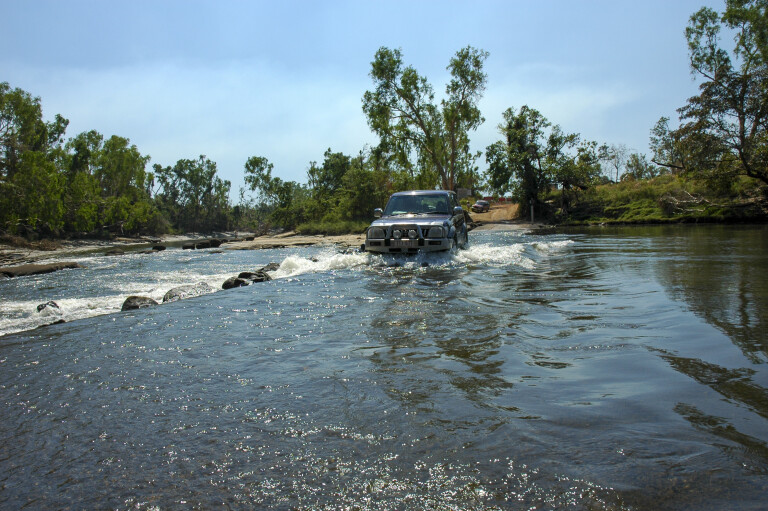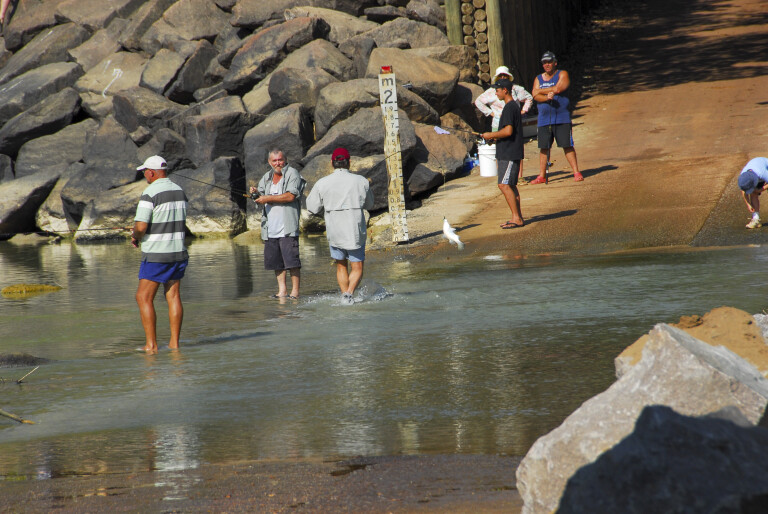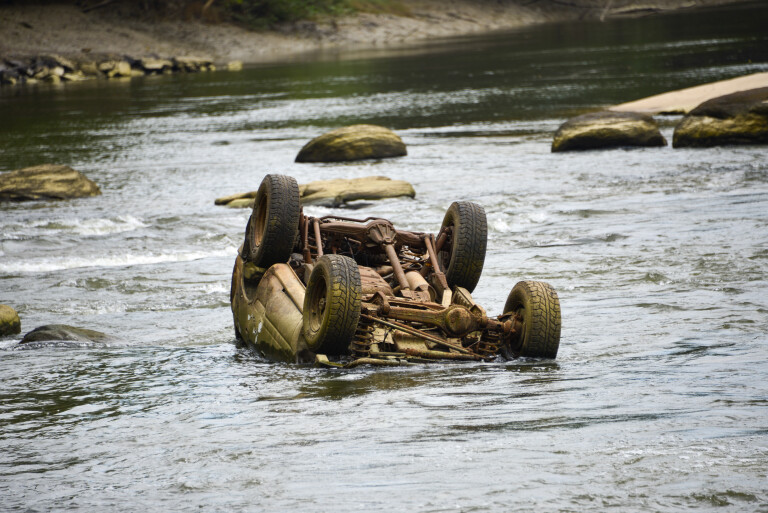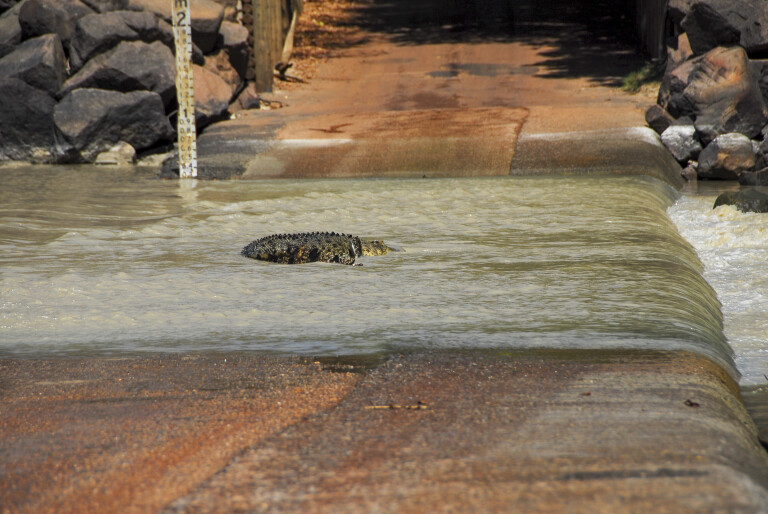
Footage captured by tour operator Jack Tanner from Cyaround Australia Tours shows a family fishing and playing on Cahills Crossing, an extremely dangerous causeway known for its croc-infested waters.
The crossing has a reputation for housing large quantities of these reptiles nearby. Even in this video crocs can be seen lurking in the water ... and that's not to mention the ones we can't see which might be even closer.
It's an urgent reminder to always be vigilant and remain safe when travelling these areas of Australia.
Cahill's Crossing is a well-known causeway within Kakadu National Park in the NT. Crossable at low tide, the area is a popular spot to witness crocodiles in the wild. A high-clearance 4x4 is required for touring this region, and do not cross if the water is too high (above 0.5m) or flowing too quickly!
Read Dick Eussen's yarn about his experiences traversing Australia's most dangerous causeway 👇
Adventure awaits in Arnhem Land if you survive Cahills Crossing, by Dick Eussen
Rated as the most dangerous crossing in Australia, Cahills Crossing is named after pioneer settler Paddy Cahill who was known as the “Buffalo Bill” of Australia due to his prowess as a buffalo shooter.
While the original ‘Cahills Crossing’ is a couple of kilometres upstream in the freshwater reach of the river, the existing causeway was named after him when it was constructed in 1956 – and while some sources claim it’s the original, it’s not.
Explore Australia
I first saw the crossing in the early 1960s during a fishing and hunting trip to the Alligator Rivers Region, as the area was then known by. It became the Kakadu National Park in 1979.
In May 1975, my wife Eileen and I drove into Darwin in our Series 3 Land Rover tray-back to find a city in despair and broken from its disastrous bout with Cyclone Tracy on Christmas Eve, 1974. We had permits for Mount Borradaile and Malay Bay. It was the first time I drove over Cahills Crossing and into forbidden Arnhem Land, the beginning of a grand adventure and love affair that has endured.
Arnhem Land is different to other parts of Australia as there is something primaeval, mystic and uplifting in the monsoon woodlands, the stone country of the Arnhem Land Escarpment, the rivers and beaches, that is unmatched anywhere else.

On the return, we fished and caught barramundi while standing knee-deep in the tidal waters on Cahills Crossing. It was déjà vu for three years in a row before we moved to the new town of Jabiru in 1979. In those days, the road from the Arnhem Highway junction was unsealed and badly corrugated.
A day before May Day 1976, the Magela Creek was high enough for the run-off water to sweep over the Land Rover’s bonnet in the deeper sections, but there was little flow in the creek or in the 500m S-bends melaleuca swamp and Hady’s Flats beyond.
The water was clear, and the hard dirt road was easy to follow. It’s now sealed. At the time, the Border Store had a liquor licence, and it was our first port of call. Locals from across the river had already swum or waded across and had drunk the store almost dry. The proprietor was surprised to see us and must have made a few phone calls.

We were the first vehicle in for the season, but by evening there were dozens and others kept coming in during the night, including more grog supplies for the store. The word was out in Darwin: “Cahills Crossing is open.” Camping space was tight but, being first, we picked the spot where the viewing platform is now located.
At daylight, we tackled the crossing when the tide ebbed and drove to Red Lily Lagoon to enjoy some of the best barramundi fishing ever. We returned the following year. The fishing was excellent, but due to a couple of late ‘knock-em-down’ storms, the river was running high and uncrossable. But the locals still managed to wade the slippery causeway back and forth in chain-link fashion, carrying money across and cartons of beer back to thirsty mates.
During our time at Jabiru we made the East Alligator River home but rarely fished from the causeway, preferring the comfort of my solid Savage Jabiru 3.7m tinnie powered by a 25hp outboard. With it, I explored the upper and lower region of the river, often alone, and I became acutely aware just how many large crocodiles lived in it.

The probable explanation was that the presence of so many people about the crossing kept them away from it, while warning rifle and shotgun shots were not uncommon when one did appear, nor was the odd floater ...
In the meantime, the locals, boosted by government money and royalties from the two uranium mines, Ranger and Nabarlek, were buying cars and 4WDs. They were coming to grief on the crossing, having no idea how to tackle the high water, and judging by the continual annual mishaps, they still don’t …
Old mate and I were coming back from a trip 50km downriver and had just crossed the rock bar some 2km downstream from the crossing when we noticed beer cans and an esky bobbing in the current. We scooped most of them out with a landing net – free beer!
There was more stuff floating downstream, before it hit us – someone had turned a boat over. I twisted the throttle, sped up and saw a large local sitting on a wheel below the crossing, the only part exposed from his 4WD. A woman cried out from a tree near us. She was sitting on the leaning trunk of a paperbark tree, while a small croc was eyeing her off below. I steadied the boat under the trunk and old mate lifted her into the boat. She immediately claimed the beer cans as her own … bugga!

We picked up two men from the muddy bank, before we turned our attention to the bloke on the tyre, but someone had pushed a tinnie into the river and was helping him into it. Nothing to do but take photos. Turned out that he had picked up a brand new Nissan Patrol in Darwin that day, one of those early box-like models that were called ‘bog machines’.
On a recent visit, there were three vehicles in the river and another two that had been pulled out with a loader on the bank of the Arnhem Land side. One year, a dump truck with two trailers went over the side. The driver thought he was okay with the heavy truck and trailers, but the river was high, unkind and punished him for his ignorance and lack of respect.
Before the 1980s, there were few crocodiles about the crossing, but in May 1987, old mate, Kerry McLoughlin, was fishing the run-off, the period after the Wet when the plains and rivers drain and the barramundi come on the bite.
There were other people fishing on the causeway as the road had just opened. Kerry waded across and had a few casts on the Arnhem Land side before returning, the water knee-deep and running strongly. Upstream, the head of a big crocodile surfaced alongside him. Those who saw it yelled warnings, but the current noise was too strong – the cries went unheard.

Suddenly Kerry saw the croc and ran forward, the high water and current hindering his progress. He fell and slipped off the crossing and swam to the high muddy bank where willing hands were reaching down to help him up, but to no avail as the living nightmare of the tropics leaped up, grabbed him about the head and shoulders and performed the dreaded death roll below the horrified witnesses. There have been more attacks, and due to the nature of stupid people, others will become victims.
Today, there are more than 120 crocodiles within 2km of the crossing. Twice a day the tide (up to 8m) pushes up from the Van Diemen Gulf, 100km downstream, to a few kilometres upstream from Cahills. When currents collide with the crossing, it creates powerful and dangerous conditions and drivers, mostly locals, end up in the water when vehicles are washed off it.
As far as I know there have been no serious attacks on people in the water, even though they swim for their lives in the deeper sections – some clutching desperately on to their children.
The incoming tide at Cahills is six hours behind Darwin’s tidal times, and knowledgeable drivers use it to their advantage. The most dangerous period is during the run-off season when huge volumes of run-off floodwaters rush over the causeway, but some drivers insist on challenging the river – and losing.

Having driven to Arnhem Land and back many times, I have found that the best time to cross during the run-off season is when both the incoming tide and river peak when, for a few minutes, there is no current before the tide turns and the fun begins. Water depth is generally below 80cm and easy to cross. But once the water speed picks up, forget about it or end up as lunch for the hungry crocodiles who wait with open mouths for fish to swim downriver.
Make no mistake, the crossing is only possible on the ebb tide in the run-off and during the dry season when there is little freshwater flow in the river. Hungry crocodiles are ever present, waiting for the tide to push fish in on the upstream side, before switching over to the downstream side when the tide turns. It’s truly an amazing spectacle that is unmatched anywhere else in the country, perhaps the globe. Check out the film clips on YouTube, especially the one that shows a drunk woman challenging a croc with a thong.









COMMENTS